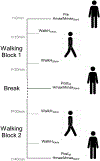Longer Duration of Downslope Treadmill Walking Induces Depression of H-Reflexes Measured during Standing and Walking
- PMID: 31032493
- PMCID: PMC6483108
Longer Duration of Downslope Treadmill Walking Induces Depression of H-Reflexes Measured during Standing and Walking
Abstract
Objectives: The Hoffman-reflex (H-reflex) is an electrophysiological technique used to evaluate the excitability of the monosynaptic spinal reflex arc. In individuals with upper motor neuron lesions who show elevated spinal excitability, a depression of spinal excitability may indicate adaptive spinal plasticity. Downslope walking (DSW), an exercise intervention comprising repetitive eccentric muscle activity, has been shown to induce depression of soleus H-reflex amplitudes while seated, however, the dose-response time-course of H-reflex modulation during DSW has not been characterized. The objectives of this study were twofold: (1) to evaluate DSW-induced soleus H-reflex depression in the standing posture and during walking, and (2) to investigate the effect of walking duration (20 minutes and 40 minutes) of DSW (-15% decline) on soleus H-reflexes, (with level walking (LW) as a control intervention).
Methods: Soleus H-reflexes were collected Pre, Post-20 minutes, and Post-40 minutes of walking in the standing position; and H-reflexes were also measured at 4 different time points during the terminal stance phase of walking.
Results: Our results showed that soleus H-reflexes evaluated in standing showed a greater % depression after DSW compared to LW, with a statistical trend for greater depression with longer durations (40-minutes). H-reflexes measured during walking showed greater depression after 40 minutes of walking compared to 20- or 30-minutes for both DSW and LW.
Conclusions: Longer duration treadmill walking (40-minutes) may induce a greater acute depressive effect on soleus H-reflex excitability compared to shorter durations (20-minutes) of treadmill walking. Future work will investigate the potential for DSW as a gait training intervention in people with upper motor neuron lesions such as multiple sclerosis and stroke.
Keywords: Hoffman’s Reflex; Neuroplasticity; Spinal Cord Plasticity; Spinal Reflex; Treadmill Training.
Conflict of interest statement
Statement of Conflicts of Interest The authors have no conflicts of interest to disclose related to this study.
Figures




References
-
- Knikou M. “The H-reflex as a probe: pathways and pitfalls”. Journal of Neuroscience Methods 1711 (2008): 1–12. - PubMed
-
- Misiaszek JE. “The H-reflex as a tool in neurophysiology: its limitations and uses in understanding nervous system function”. Muscle Nerve 282 (2003): 144–160. - PubMed
-
- Zehr EP. “Considerations for use of the Hoffmann reflex in exercise studies”. European Journal of Applied Physiology 866 (2002): 455–468. - PubMed
-
- Morita H., et al. “Modulation of presynaptic inhibition and disynaptic reciprocal Ia inhibition during voluntary movement in spasticity”. Brain 1244 (2001): 826–837. - PubMed
-
- Shin S., et al. “A Test of the Rambling and Trembling Hypothesis: Multiple Sclerosis and Postural Control”. Motor Control 154 (2011): 568–579. - PubMed
Grants and funding
LinkOut - more resources
Full Text Sources
